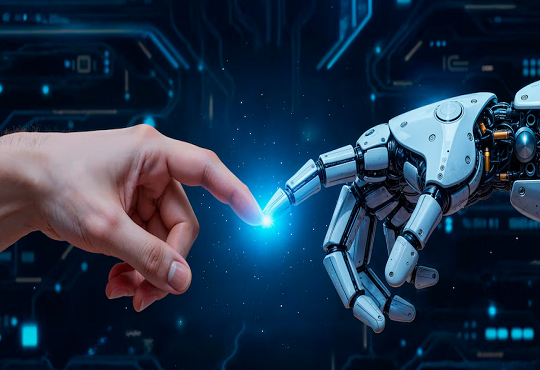
Implementing IoT and AI in Infrastructure and Mining Projects
Bhavesh Singhavi, Co-founder of InstaDigin

Bhavesh Singhavi, Co-founder of InstaDigin, shared his insights in an interaction with CIOTechOutlook on leveraging IoT and AI in mining operations. He discussed how integrating IoT sensors can help monitor equipment and ensure worker safety in real-time. Singhavi highlighted that data-driven decision-making improves fleet utilization, reduces downtime, and boosts productivity. He also addressed key challenges such as ensuring data reliability in harsh mining environments and integrating AI with legacy systems.
In addition, he emphasized the role of AI in optimizing energy usage and the importance of training staff to work effectively with these technologies. He advised mining businesses to embrace digital transformation as a vital step toward the industry's future.
Singhavi brings over 15 years of experience in the mining and infrastructure industry. He holds a B.Tech in Mineral Engineering from IIT (ISM) Dhanbad and is a CFA Charterholder (USA). At PwC India’s mining advisory practice, he worked with private firms, PSUs, and government organizations across India, Canada, Brazil, Africa, and the Middle East. His work involved developing strategic business plans, policy frameworks, and financial feasibility analyses to address complex challenges in the mining sector.
The integration of IoT sensors in mining operations is transforming real time monitoring of equipment and worker safety. How can data collect from these sensors be effectively used to optimize productivity and reduce operation risks?
The integration of IoT sensors in mining operations is revolutionizing real-time monitoring of equipment and worker safety. Data collected from these sensors can be effectively harnessed to optimize productivity and reduce operational risks across the mining value chain - exploration to dispatch.
IoT sensors enable continuous, accurate tracking of equipment performance and workforce safety conditions. Real-time data streaming supports intelligent fleet management by improving automation, scheduling maintenance proactively, and maximizing equipment availability. For example, dynamic fleet allocation such as mapping dumpers to excavators helps streamline cycle times and significantly enhances operational productivity.
Safety can also be greatly enhanced, with real-time alerts about hazardous zones or emergency conditions empowering workers and supervisors to act swiftly, ensuring safer execution of planning, production, and dispatching tasks.
When integrated with AI, IoT data unlocks deeper operational insights—enabling pattern recognition, anomaly detection, and process optimization. Additionally, centralized dashboards provide supervisors with a real-time, holistic view of operations, supporting data-driven decision-making.
Beyond efficiency and safety, IoT data contributes to energy efficiency by tracking fuel consumption and emissions, aligning operations with ESG goals and regulatory compliance. These systems are also modular and scalable, making them particularly well-suited for junior and mid-tier miners looking to adopt digital solutions in a phased, cost-effective manner.
With IoT and having smart tracking of assets and resources in remote mining location, what are the key challenges in ensuring data reliability and connectivity in these harsh environments?
Smart tracking of assets and resources in remote mining locations presents significant challenges, particularly in ensuring data reliability and maintaining connectivity in harsh environments. IoT devices must operate reliably despite extreme conditions such as dust, high temperatures, and constant vibrations, which can degrade hardware performance over time.
Additionally, these remote sites often suffer from limited or unstable or non-existent telecom infrastructure, making consistent data transmission difficult. The need for low-latency data processing clashes with limited bandwidth and intermittent network availability, complicating real-time monitoring efforts.
Another significant challenge is the scarcity of trained personnel on-site who can perform basic IoT hardware troubleshooting and routine maintenance, leading to prolonged downtimes when hardware issues arise. Without adequate training and support, mining operations become heavily dependent on remote teams, which can delay problem resolution and reduce operational resilience.
Considering the rise of AI driven predictive maintenance, what challenges do you foresee in integrating AI with legacy infrastructure in mining operations?
Integrating AI-driven predictive maintenance with existing infrastructure in mining operations presents several challenges. Most organizations rely on disparate systems - such as ERP and plant maintenance software - that operate in silos, making seamless data integration difficult. Additionally, mining fleets, including excavators and dumpers, often consist of diverse models from different eras. While modern equipment is equipped with advanced sensors for data acquisition, older machinery poses challenges for data collection, even when retrofitted with sensors, due to integration complexities.
Although older systems are being updated to enable compatibility with AI tools, this process is complicated by increasing cybersecurity threats, as legacy systems may lack robust security controls. Overall, integrating AI with legacy infrastructure presents significant technical and organizational challenges that require careful planning and execution.
Energy efficiency is a growing priority in mining and infrastructure. How can AI powered energy management systems in conjunction with IoT contribute to sustainable goals?
Energy efficiency is an increasing priority in the mining and infrastructure sectors, which have traditionally scored low on ESG factors, particularly environmental aspects and are often perceived as polluting industries. Stakeholders, including regulators, investors, and local communities, are progressively emphasizing the need for sustainable operations. By combining AI with the Internet of Things (IoT), processes such as fleet management become more efficient, leading to reduced fuel consumption and lower carbon emissions. Real-time data monitoring enables companies to track energy usage patterns, identifying periods of highest and lowest electricity consumption.
Additionally, companies are adopting renewable energy sources like wind and solar to comply with regulatory requirements and improve overall energy management.
Evolving ESG reporting frameworks at both national and international levels demand accurate data collection. IoT and AI technologies support this by facilitating real-time data acquisition and predictive analytics, thereby enhancing both reporting accuracy and operational optimization.
Given the harsh and remote conditions of mining environments, how can IoT sensors are reliably implemented to monitor structural health and ensure worker safety in real time?
Implementing IoT sensors reliably in harsh, remote mining environments requires rugged devices designed to withstand dust, temperature extremes, and vibrations, with durability of at least two to three years. These sensors, worn by workers or installed on machinery, monitor key parameters to enhance safety.
Challenges include ensuring data reliability amid unstable connectivity and limited power supply. Solutions involve high-quality hardware with strong IP ratings, multiple connectivity options (4G, 2G fallback, Bluetooth, Wi-Fi), and secure data transmission. The emergence of private 5G networks and edge computing helps reduce latency and dependence on constant connectivity.
Instant alerts and emergency broadcasts via smart wearables improve response times, while AI-enabled cameras monitor safety gear compliance and restricted area access. Training on-site personnel for basic troubleshooting and maintenance is vital to reduce downtime and increase operational resilience.
Given the skills gap in handling AI and IoT systems, how can workforce training be aligned to ensure smooth adoption in infrastructure and mining sectors?
The mining and infrastructure sectors face challenges in attracting young talent due to harsh working conditions and remote locations. Adoption of AI and IoT can help modernize the industry and make it more appealing to skilled workers. Successful integration requires top-down leadership, as digital initiatives are often driven by ROI considerations. Senior management must prioritize implementation and ensure adoption at the ground level. Companies should invest in continuous digital upskilling and interdisciplinary training that blends operational and technical expertise.
Collaboration with educational institutes, startups and technology companies can provide tailored training sessions focused on relevant use cases. Practical, hands-on training and simulation exercises are crucial to help workers build confidence and experience with new systems.
Employees often fear that digital adoption may render their jobs obsolete. It is important to communicate that AI and IoT automate certain tasks, reducing work pressure and mundane activities while creating opportunities to develop new skills, rather than replacing the workforce. Clear communication and change management strategies can ease concerns and foster a culture of innovation.
Finally, redefining job roles to include digital competencies and outlining career progression pathways encourages employee engagement and retention during this transition.
CIO Viewpoint
Why Foolproof Facial Recognition Is Key Against...
By Joseph Sudheer Thumma, Global CEO & MD, Magellanic Cloud
National Technology Day 2025: Powering Progress...
By CIOTech Outlook Team
Aligning IT Roadmap with Business Objectives: A...
By Subhash singh Punjabi, CISO & Head Enterprise Architecture, Deepak Fertilisers & Petrochemicals Corporation Ltd
CXO Insights
Making the Business Case for Managed Print
By Rob Ince, Senior Director, Managed Print Services, ITsavvy
Managed Print Services: Your Secret Defense...
By Tim O'Shea, Director MPS Operations & Business Development, Oki Data Americas, Inc.
You Can Reduce Your Print Outs, but You Still...







